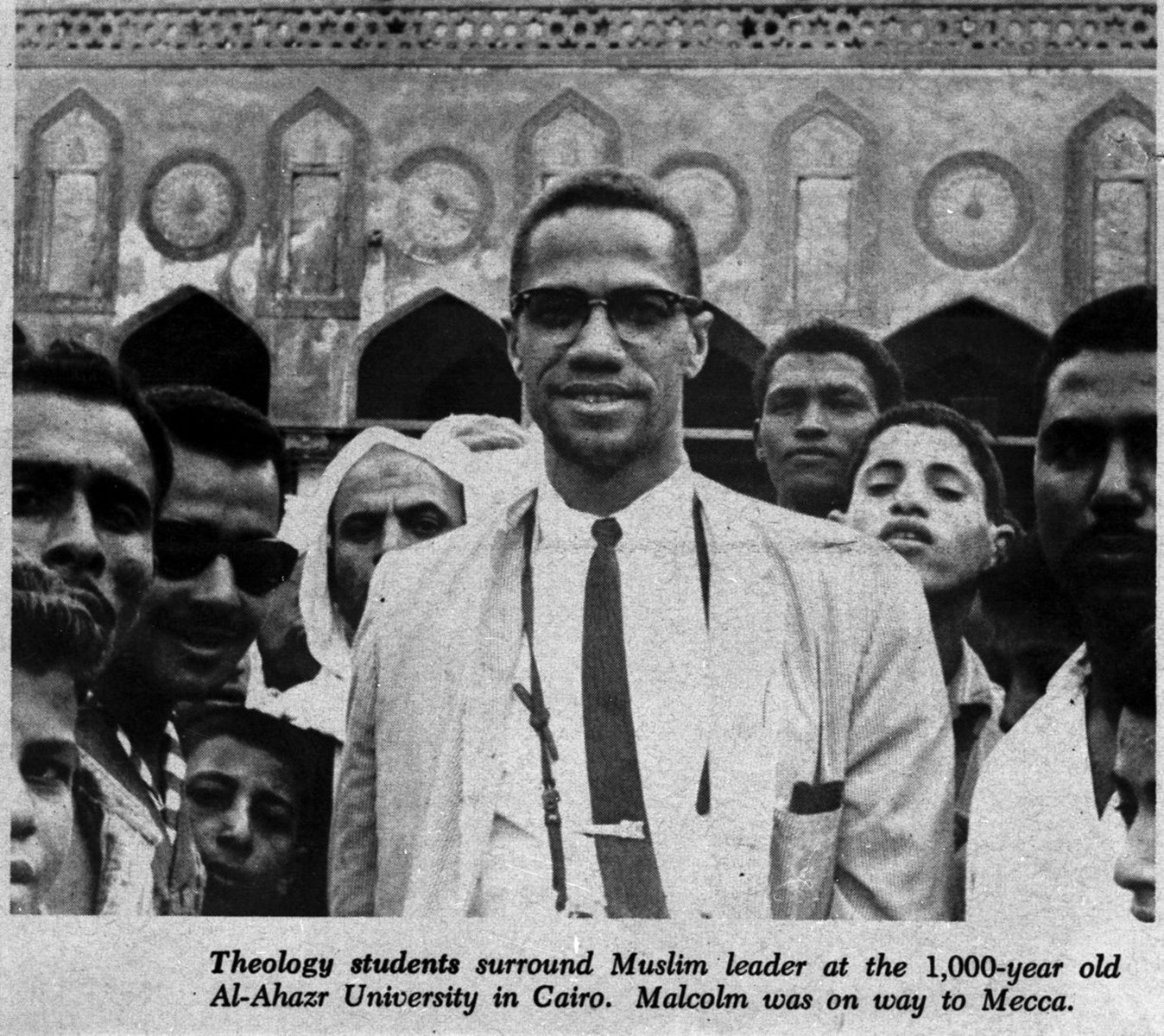Civil Rights or Human Rights?
Lesson by Andrea McEvoy Spero
Theology students surround Malcolm X at Al-Ahzar University in Cairo. © Moorland-Spingarn Research Center, Howard University Archives, Howard University, Washington DC
Why have the international dimensions of the African American struggle for human rights been neglected in most high school history courses? Textbooks tend to present the Civil Rights Movement as a distinctly U.S.-based event, from Montgomery to Memphis, with the Voting Rights Act of 1965 as its crowning moment. The term "civil rights" limits our understanding, since it refers specifically to rights guaranteed by the Constitution or protected through legislation. It fails to encompass the cultural, social, and economic goals of the struggle. Desegregation and voting rights were a means to achieve broader goals, such as overcoming social forces that limit freedom and opportunity.
Not only did the goals of the African American Freedom Struggle extend beyond civil rights, they were often inspired by the anticolonial struggles of the 20th century. To conceptualize the African American Freedom Struggle as part of a global movement for human rights invites a deeper understanding of the international events of the last century. In this lesson, we explore the steps that we, as educators, can take to reframe the traditional "civil rights" narrative.
Grade Level: Middle and high school
Time Required: Three to five class periods
Essential Question
In what ways was the African American Freedom Struggle, better known as the Civil Rights Movement, part of a global movement for human rights in the 20th century?
What are the major events and goals of the African American Freedom Struggle and how are they related to the Universal Declaration of Human Rights?
What were the international dimensions of the African American Freedom Struggle in relation to other movements against oppression?
Why did Malcolm X ask African leaders in 1964 to investigate human rights violations in the United States?
Is the traditional framing of the struggle as a Civil Rights Movement accurate?
Lesson Outline
Part 1: Timeline Activity: Freedom Is on the Move
Part 2: United Nations’ Commission on Human Rights
Part 3: Analyzing Documents
Culminating Project: Civil Rights or Human Rights?
Here are descriptions of the three parts and culminating activity. Download full lesson below.
Part One: Freedom Is on the Move
Students create an “African American Freedom Struggle Timeline and Map” on a classroom wall and relate the Universal Declaration of Human Rights (UDHR) to the timeline’s events. They begin with a timeline on the wall marked with the decades 1940, 1950, 1960, and 1970. As reference documents, they refer to the Universal Declaration of Human Rights and the timeline, “The African Freedom Struggle, An International Perspective, 1942-1967,” cut into strips.
The timeline introduces students to thirty key events that illustrate the reciprocal relationship between the U.S. Civil Rights Movement and the international human rights movement, especially the campaigns against colonialism and in support of economic and social rights. The chronology begins with the Double V campaign and ends with King’s Riverside Church address criticizing the Vietnam War, but is certainly not exhaustive. Students can be encouraged to research additional events, and teachers can facilitate in-depth discussions regarding the international dimensions of the struggle.
Part Two: The United Nations Commission on Human Rights
In July 1964 Malcolm X attended the second meeting of the Organization of African Unity. He presented a petition asking, “In the interest of world peace, we beseech the heads of the independent African states to recommend an immediate investigation into our problem by the United Nations Commission on Human Rights.” According to UN procedures, a nation can request a human rights investigation of another country on behalf of the people whose rights have been violated. The African heads of state discussed the proposition at the OAU summit but failed to bring the case before the UN based in part because of pressure from the U.S. State Department. Although the United Nations Commission of Human Rights never conducted the investigation, students will create a mock hearing and investigation. This simulation allows students to examine the human rights violations within the United States during the 1950s and 1960s, viewpoints of African American leaders of the time, and the Universal Declaration of Human Rights. This exercise also serves as a model for potential investigations of current violations. Students will run the hearing, present various viewpoints, and act as journalists reporting on the investigation.
Part Three: Students analyze three primary source documents from the African American Freedom Struggle of the 1950s and 1960s
The first document is from the March on Washington for Jobs and Freedom and encourages students to examine the goals of the march through a human rights framework. The second and third documents provide examples of the relationship between the human rights struggles in the United States and in South Africa.
Culminating Assignment
Students examine common perceptions of the “Civil Rights Movement” and create an educational tool to inform others about the international dimensions of the African American Freedom Struggle and its central theme of human rights. Students will choose from a selection of quotes to guide their project.

